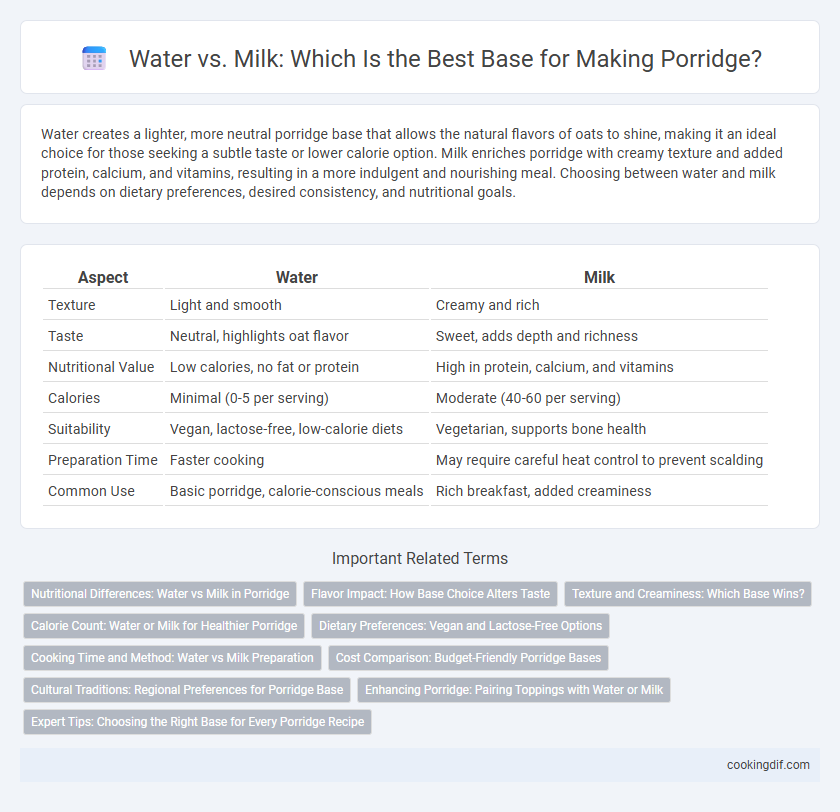Water creates a lighter, more neutral porridge base that allows the natural flavors of oats to shine, making it an ideal choice for those seeking a subtle taste or lower calorie option. Milk enriches porridge with creamy texture and added protein, calcium, and vitamins, resulting in a more indulgent and nourishing meal. Choosing between water and milk depends on dietary preferences, desired consistency, and nutritional goals.
Table of Comparison
| Aspect | Water | Milk |
|---|---|---|
| Texture | Light and smooth | Creamy and rich |
| Taste | Neutral, highlights oat flavor | Sweet, adds depth and richness |
| Nutritional Value | Low calories, no fat or protein | High in protein, calcium, and vitamins |
| Calories | Minimal (0-5 per serving) | Moderate (40-60 per serving) |
| Suitability | Vegan, lactose-free, low-calorie diets | Vegetarian, supports bone health |
| Preparation Time | Faster cooking | May require careful heat control to prevent scalding |
| Common Use | Basic porridge, calorie-conscious meals | Rich breakfast, added creaminess |
Nutritional Differences: Water vs Milk in Porridge
Using water as the base for porridge results in a lower calorie and fat content, making it ideal for a lighter meal. Milk enhances the porridge's protein, calcium, and vitamin D levels, supporting bone health and muscle function. The choice between water and milk impacts the nutritional profile, influencing energy intake and nutrient density.
Flavor Impact: How Base Choice Alters Taste
Using water as the porridge base results in a lighter, more neutral flavor that allows toppings and spices to stand out, while milk creates a creamier, richer taste with a naturally sweet undertone. Milk's lactose content enhances the porridge's overall mouthfeel and caramelization during cooking, intensifying flavor complexity. Choosing milk also adds subtle dairy notes that complement grains better than water, making the dish feel more indulgent and satisfying.
Texture and Creaminess: Which Base Wins?
Milk creates a richer, creamier texture in porridge due to its fat content and proteins that thicken the dish as it cooks. Water-based porridge has a lighter, less creamy consistency, allowing the natural grain flavor to stand out more prominently. Creaminess and mouthfeel preferences often lead to milk being the preferred choice for a velvety porridge texture.
Calorie Count: Water or Milk for Healthier Porridge
Using water as the base for porridge results in a lower calorie count compared to milk, making it a preferred choice for calorie-conscious individuals. Milk contributes additional calories from fats, proteins, and sugars, enhancing porridge's nutritional density but increasing overall energy intake. Selecting water reduces calorie load and supports weight management while milk offers a richer, creamier texture with added nutrients like calcium and vitamin D.
Dietary Preferences: Vegan and Lactose-Free Options
Water serves as an ideal base for porridge in vegan and lactose-free diets, ensuring the meal remains dairy-free and suitable for those with lactose intolerance. Milk alternatives such as almond, soy, or oat milk provide creamy textures and added nutrients while maintaining adherence to dietary preferences. Choosing these bases supports digestive comfort and meets vegan nutritional requirements without compromising taste or texture.
Cooking Time and Method: Water vs Milk Preparation
Cooking porridge with water results in a faster cooking time due to its lower fat content and absence of proteins that can thicken the mixture, allowing oats to soften more quickly. Milk requires a gentler simmer and longer cooking time to prevent curdling and ensure even heat distribution, often demanding constant stirring to avoid scorching. Using a water base simplifies the preparation process, while milk-based porridge yields creamier texture but demands more precise heat control and patience.
Cost Comparison: Budget-Friendly Porridge Bases
Water serves as the most budget-friendly base for porridge, costing significantly less than milk while maintaining nutritional value when paired with grains like oats or barley. Milk, though richer in flavor and nutrients such as calcium and protein, substantially increases the overall cost per serving compared to water. Choosing water as a porridge base optimizes affordability without compromising the fundamental energy provided by carbohydrates.
Cultural Traditions: Regional Preferences for Porridge Base
Regional preferences for porridge bases vary significantly, with water favored in many Asian cultures for a lighter, more digestible texture, while milk is preferred in Western countries for a creamier, richer consistency. In East Africa, porridge often uses water or diluted milk to balance nutrition and cost-effectiveness, reflecting local dietary habits. Scandinavian traditions typically incorporate milk to enhance flavor and caloric content, aligning with colder climates and higher energy dietary needs.
Enhancing Porridge: Pairing Toppings with Water or Milk
Using milk as the porridge base creates a richer, creamier texture that pairs exceptionally well with sweet toppings like honey, berries, or cinnamon, enhancing the overall flavor profile. Water-based porridge offers a lighter, more neutral canvas, allowing bold toppings such as nuts, seeds, or savory ingredients like cheese and herbs to stand out. Choosing between water or milk as the base significantly influences the absorption and melding of flavors from toppings, optimizing the porridge eating experience.
Expert Tips: Choosing the Right Base for Every Porridge Recipe
Experts recommend selecting the porridge base based on desired texture and flavor, with water producing a lighter, more traditional consistency, while milk adds creaminess and richness. For nutrient boost and smoother mouthfeel, whole or plant-based milk enhances protein and calcium content, complementing oats' natural fiber. Adjust liquid ratios accordingly to prevent burning or excessive thickening, ensuring perfect porridge consistency every time.
Water vs milk for porridge base Infographic

 cookingdif.com
cookingdif.com